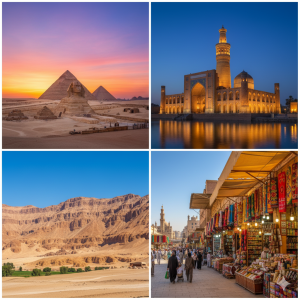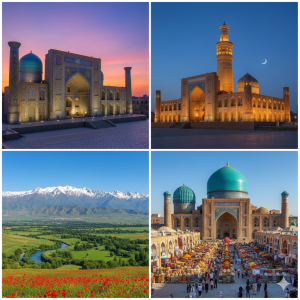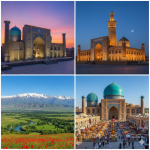
Imagine stepping off your plane into a world where centuries of Silk Road history remain alive in turquoise domes, bustling bazaars, and warm smiles. As someone who’s spent more than a decade exploring Uzbekistan’s cities, remote valleys, and hidden corners, I can tell you: it can surprise you in all the best ways.
In this Uzbekistan travel guide, I’ll walk you through everything you need to plan a smooth, rewarding trip: from flying in with Uzbekistan Airlines, to what you absolutely must know before you go, to the details of how to get an e-visa. Along the way I’ll share stories, tips, and mistakes I’ve made so you don’t repeat them. By the end, you’ll feel confident booking your trip and navigating Uzbekistan like a pro.
Why Visit Uzbekistan — My First Impressions
When I first went to Uzbekistan, I had low expectations: I saw it as one of many post-Soviet “exotic” stops. But within hours in Tashkent I realized I’d underestimated it. The mix of Soviet architecture, blue-tiled madrasas, lively teahouses, and the sincere hospitality of local people won me over.
Over the years, I’ve returned dozens of times. What keeps drawing me back:
- Overlooked heritage: The Silk Road cities of Samarkand, Bukhara, Khiva teem with Islamic art and history, yet see fewer crowds than many in Europe.
- Ease of travel improvements: High-speed trains (such as Afrosiyob, connecting Tashkent to Bukhara via Samarkand) have transformed connections.
- Friendly locals and safety: In a Reddit post, a solo traveler said, “Uzbekistan was completely safe. Never once felt unsafe … the country isn’t very touristic.”
- Affordable value: You can enjoy great food, private guiding, and comfortable midrange hotels at a fraction of what similar experiences cost in Europe.
When you follow this guide, I promise you’ll have fewer surprises, a firmer plan, and a deeper appreciation for what makes Uzbekistan special.
Uzbekistan Airlines — Tips for Flying In and Within the Country
Using national carriers and domestic flights wisely can save you time and headache. Here’s what I know from years of flying around Uzbekistan.
Uzbekistan Airlines (Uzairways) — what to expect
- The official site Uzairways.com provides features like online check-in / registration, flight schedule, seat selection, etc.
- You can check in online by entering your ticket number and last name; a boarding pass (with QR) is sent via email.
- Even though online check-in is allowed, many airports require you to print a paper boarding pass once you arrive. Always carry your boarding pass in printed form.
- For foreign citizens, the website “Visa rules for foreign citizens” gives updated rules on visa waivers and simplified visa regimes.
From my experience, there are a few things to keep in mind:
- Book early: Domestic flights (for example, Tashkent → Urgench for Khiva) often get sold out weeks in advance.
- Weight and baggage: Familiarize yourself with baggage allowance; if your luggage is heavy, you may need to pay extra at the airport.
- Timing matters: In the early years, domestic flights often run early morning or late evening. Plan buffer time around connections.
- Reliability: I’ve had delays, but nothing disastrous. One time a domestic flight got rescheduled; I rebooked via rail instead.
- Alternate to flights: For some legs (e.g. Tashkent ↔ Samarkand ↔ Bukhara) it’s faster and more scenic to take the high-speed train rather than fly.
In sum, Uzbekistan Airlines is a useful tool in your travel toolkit — but combine with trains and plan margins.
What Should You Know Before Traveling to Uzbekistan
If you skip this part, you’ll run into avoidable hassles. Here’s a checklist from my years of travel.
Best time to visit
- Spring (March to May) and autumn (September to early November) are ideal: moderate temps, clear skies.
- Summer (June–August) can get extremely hot, especially in desert regions.
- Winters are cold, and some remote places may be inaccessible due to snow.
Passport, visa, stay rules
- Your passport should be valid at least 3 months beyond your intended stay.
- Many nationalities get visa waiver access or simplified tourist visa processing.
- Be sure you don’t overstay — fines or problems may follow.
- Bring a few blank pages for stamps.
Currency and payments
- The currency is the Uzbekistan som (UZS).
- In major cities, credit cards are accepted in better hotels and restaurants, but not everywhere — always carry cash.
- When entering or leaving with amounts equivalent to $2,000+ in currency you must declare it.
- ATMs exist in Tashkent, Samarkand, Bukhara — but in rural or small towns you might not find reliable ones.
Language and communication
- Uzbek and Russian are widely spoken. English is less common outside tourist hubs.
- Download a phrasebook or offline translator — many locals appreciate even basic attempts at Uzbek or Russian.
- Get a local SIM or eSIM early; data helps with navigation, rail bookings, translation.
Health, safety, and insurance
- No special vaccinations are officially required for most travelers, but always check your own country’s travel advice.
- Drinking tap water is generally not advised; bottled water is cheap and abundant.
- Purchase travel insurance covering trip cancellation, medical, stolen items.
- Keep an eye on your belongings at busy bazaars or transport hubs (my one experience of petty theft was when I left a camera strap loose in a busy market).
- In a travel forum, someone noted domestic taxis sometimes overcharge — always agree on a price first.
Transportation within Uzbekistan
- Rail travel is comfortable, affordable, and efficient — the high-speed Afrosiyob trains allow you to cover Tashkent → Bukhara / Samarkand much faster than old rails.
- Buses, shared taxis, marshrutkas (minibuses) are options for short distances.
- For remote areas or rural exploration, rent a car with a driver or hire local guides.
- Be realistic about travel times; distances may look small on a map, but roads may be slower.
Cultural norms and etiquette
- Uzbekistan is a predominantly Muslim country, though secular in many ways.
- Dress modestly, especially in religious sites — shoulders and knees should be covered.
- Always ask before photographing people, especially in small villages or conservative areas.
- Removing shoes before entering mosques or homes is expected.
- Tipping is appreciated in restaurants, hotels, guides.
From all those years, the more you prepare for “adulting” things (money, tickets, logistics), the more energy you’ll have to enjoy the magic.
How to Get an E-Visa for Uzbekistan
One of the things that has improved massively over the last decade is visa access. Getting your Uzbekistan e-visa is straightforward — but it comes with caveats.
What is the e-visa system?
Uzbekistan operates an e-visa portal where you submit your application and pay online.
Some nationalities enjoy visa-free entry for up to 30 days.
Those in the visa-free group don’t need to apply via e-visa but must still meet entry criteria (passport validity, etc.).
Steps to apply
- Go to our e-visa site: visatouzbekistan.uz
- Fill an application form with personal info, passport data, travel dates.
- Upload a photo/scanned passport page.
- Pay the fee.
- Wait for processing.
- Download or print the approved e-visa — you need a hard copy for border control; an e-copy isn’t enough.
How much does it cost?
- Single-entry e-visa: about USD 60
- Double-entry: about USD 75
- Multiple-entry : about USD 100
- Note: the fees are non-refundable even if your application is denied or you cancel your plans.
Important caveats and tips
- No edits allowed: If you make a mistake (name, passport number), you likely have to apply anew. (That’s why our experts are ready to provide you with their professional support. visatouzbekistan.uz)
- Entry through any border crossing point is allowed with the e-visa.
- Always carry the printed e-visa with you during your trip — you may need to show it internally.
- The e-visa does not get stamped into your passport; it must remain separate.
From personal experience: I once applied late and got approval just hours before the flight — stressful, but it worked. As a rule: apply at least 5–7 days ahead of your trip.
Sample Itinerary and Must-See Highlights
A travel guide isn’t complete without recommendations on where to go and how much time to allow. Here’s a sample 8- to 10-day plan drawn from my travels, along with must-see stops and side trips.
8–10 Day Itinerary Outline
Here’s a popular route many travelers, including myself, follow:
- Day 1: Arrive in Tashkent, rest, short stroll
- Day 2: Explore Tashkent (Chorsu Bazaar, Amir Timur Square, metro)
- Day 3: Train or flight to Samarkand, afternoon in Registan
- Day 4: Full day in Samarkand (Gur-e-Amir, Bibi Khanym, Shah-i-Zinda)
- Day 5: Travel to Bukhara, evening stroll in the old town
- Day 6: Bukhara (Ark Fortress, Lyab-i-Hauz, Kalon Minaret)
- Day 7: Travel to Khiva (via Urgench)
- Day 8: Explore Khiva (Ichan-Kala, Kunya Ark, Islam Khodja)
- Day 9–10: Return to Tashkent, optional day trip, depart
Many travellers suggest splitting days in longer stops if possible.
Highlights and hidden gems
- Registan Square (Samarkand): Undoubtedly one of the most stunning ensembles of madrasas you’ll ever see.
- Lyab-i-Hauz, Bukhara: A peaceful plaza with trees, water, and historical buildings around — great afternoon rest spot.
- Ichan-Kala (Khiva): Walking within the old fortress walls feels like stepping into another era.
- Tashkent metro stations: The stations are works of art, each with unique design themes.
- Zaamin National Park: If you want to break away from cities, I recommend a day in Zaamin — lush valleys and fresh air in contrast to the desert.
- Kamchik Pass road trip: The drive through Kamchik Pass between Tashkent and the Fergana Valley showcases mountain vistas.
Example personal anecdote
On one trip, I had a spare afternoon in Bukhara after visiting the main sites. I hired a local taxi driver and asked him to take me to an off-map village nearby. He drove along dusty backroads, stopped to show me a small shrine, and introduced me to an elderly family who served me chai (tea) in their courtyard. No guide, no tour — just serendipity. That’s the kind of magic you can still find in Uzbekistan if you leave wiggle room in your plan.
Practical Tips & Mistakes to Avoid
After 10+ years, I’ve learned things the hard way. Here are tips to make your trip smoother.
Book early for trains and flights
Especially during peak season, tickets for trains and domestic flights sell out fast. In forums, travelers advise booking a few days ahead.
Stay flexible around rest days
Some places wear you down — long drives, heat, jet lag. I always leave “buffer days” where I don’t plan too much, so I can rest or explore locally.
Use local guides in historic cities
Having a local guide in Samarkand or Bukhara matters. They’ll tell you stories behind tile inscriptions, point out hidden tombs, and help you skip lines.
Photographic gear cautions
Bring enough memory cards, spare batteries, and always ask before taking photos of locals. Don’t flash very expensive gear — subtlety helps.
Accommodation quality varies
In big cities hotels are reliable; in smaller towns, standards may drop. Always check recent photos and reviews, and ask what amenities (hot water, heating, Wi-Fi) actually work.
Respect local customs
- In mosque areas, adhere to dress codes (covering arms/legs, headscarves for women in some places).
- Don’t walk into a mosque or madrasah during prayer times unless allowed.
- In bazaars, bargaining is normal — but stay polite.
- Always remove shoes when entering religious settings or some homes.
Health & personal safety
- Carry a small first aid kit: painkillers, rehydration salts, basic wound supplies.
- If traveling in remote regions, bring snacks or energy bars — shops may be sparse.
- Stay updated on travel advisories from your country.
- Register with your embassy or let a friend or family know your itinerary.
Over the years, I’ve had one missed train (got to station too late), one passport mishap (forgot photocopy), and one budget hotel that turned out to have no heating. Each of those taught a lesson I tuck in my checklist now.
By now, you have a full Uzbekistan Travel Guide covering essential logistics (like Uzbekistan Airlines and e-visa), what you need to know before traveling, an itinerary, and tips from real experience.
The journey ahead is yours. Book your tickets, apply for your e-visa early, and let your curiosity lead you through markets, mausoleums, mountain passes, and the roofs of ancient medressas. If you want help refining your route (e.g. 7 days vs 14 days), or a printable checklist, I’d be happy to help.
Let me know where you plan to go first — Tashkent, Samarkand, or Bukhara — and I can suggest a tailored mini-itinerary for you.
FAQs
Q: How many days are enough to see Uzbekistan?
A: In my opinion, 7 to 10 days offers a solid balance: you can hit Tashkent, Samarkand, Bukhara, and Khiva without rushing too much. If you stay 14 days, you can explore Fergana, Nurata Mountains, and other outskirts.
Q: Can I enter Uzbekistan visa-free?
A: Yes — citizens of certain countries enjoy visa-free stays up to 30 days. For others, you’ll need to apply for an e-visa via our website.
Q: Which is better: train or flight between cities?
A: For many routes (Tashkent ↔ Samarkand ↔ Bukhara), the high-speed train is faster, more reliable, and more scenic than flying. For remote legs (e.g. Tashkent → Urgench / Khiva), a domestic flight may make sense if timing and availability permit.






